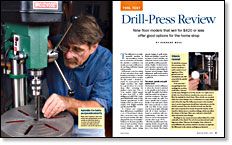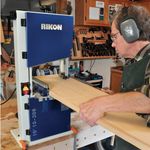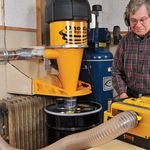Tool Test: Drill-Press Review
Nine floor models that sell for $420 or less offer good options for the home shop
Synopsis: Bernard Maas compares nine 15-in. to 17-in. full-height, lower-priced drill presses that might be chosen for a home shop. A comparison chart, along with details on how he evaluated them, includes information on changing speeds, depth stops, and tilt mechanisms. He also offers tips on how to check for chuck runout.
From Fine Woodworking #162
The drill press is an indispensable machine in any woodshop. A number of accessories can broaden the machine’s usefulness, but mostly, you want a drill press to do one thing: Drill holes cleanly and accurately.
Drill presses come in a variety of sizes and prices, from small benchtop machines to heavier production-level floor models. For this review, I decided to search for lower-priced, fullheight machines that might be a good choice for a home shop. After surveying the market, I chose nine 15-in. to 17-in. models, which ranged in price from $297 to $419: Bridgewood BW1785F, Craftsman 00922917000, Delta 17-965, General International 75-200, Grizzly G7947, Jet JDP17, Powermatic 1170, Ridgid DP15500 and Woodtek 816-805.
To evaluate and compare these drill presses, I established a set of broad-based criteria. First, I took note of the condition of each machine after shipping and the ease of assembly. I looked over the basic specifications of each machine: chuck-to-post distance, table size, overall height, motor rating, speeds, length of quill stroke, finish and stability.
I tested the accuracy of each machine out of the box: runout on the chuck and spindle-to-table perpendicularity. Finally, I looked at how each machine operated: noise level, vibration, table-height adjustment, speed changes, depth adjustment, quill-return tension and the presence or absence of a quill lock.
The business end of a drill press is where the chuck is attached to the spindle at the bottom of the quill. The quill is the hollow shaft that makes the plunge toward the workpiece. The spindle turns within the quill. You want a spindle that is perpendicular to the table and a chuck that rotates perfectly on center with very little, if any, runout. Although with all of these machines I found no problems with perpendicularity, I did find variances in runout measurements.
For the full article, download the PDF below.
Fine Woodworking Recommended Products

Rikon 10-3061 10-in. Deluxe Bandsaw
The saw has two speeds: 3,280 sfpm (surface feet per minute) for wood and 1,515 sfpm for soft metals and some plastics.

Veritas Precision Square























Log in or create an account to post a comment.
Sign up Log in